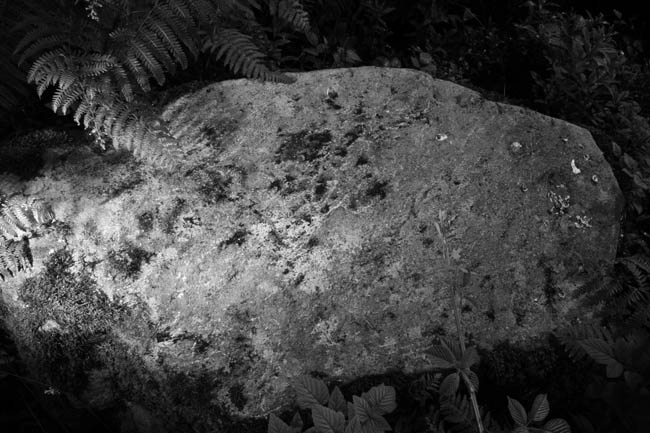


The main thing that struck me about this place was how different all the stones are. Red ones, smooth ones, grey ones, crinkly ones, quartzy ones, allsorts. A couple of them looked to have possible cups, but on closer inspection, these proved to be totally natural.
Halfway up a hill seems an odd spot for such a thing, but there must have been a reason, makes it easier to get to for one thing. If you’re passing from Machrie to head to Ardrossan or Brodick (or vice versa), it’s worth stopping and making the short hop up from the road.

You can just about make out the cups and rings.

Desperate attempt to show up the worn cups and rings.
(Didn’t really work did it?)

Views to the east, over Kilmartin Glen, obscured by bracken.
Visited July 2006
I was slightly disappointed with my experience of this stone, though that was largely due to the poor light in which I saw it. It was more or less mid-day, with bright summer sunlight. This made the motifs (mostly cups, but with a couple of rings) difficult to see. They are quite worn, they do have quite a covering of lichen, so it was difficult to reconcile it with the diagram in Stan Beckinsall’s book.
On the plus side, the stone is easy to find, being just to the left of the forestry track. In a better light, it should be easier to see the arkings. Given that the views are to the east, morning would probably be the best time. Evening would probably not be a good time, as immediately to the west, there is naught but hillside, so the stone would be in shadow.
(A word of warning, the whopping great trucks come belting down that track at some speed, as they aren’t expecting to see anyone. The stone is on a bend, so don’t be tempted to leave anything hanging about on the track, lest it get flattened)
From The Telegraph’s website
Gristhorpe Man, who was found buried in a tree trunk in the 19th century, has been identified as a Bronze Age warrior chieftain by archaeologists.
The skeleton of Gristhorpe Man, excavated near Scarborough in 1834. Although a few examples of burial in a scooped-out oak tree have been found in Scotland and East Anglia, it was an unusual method and the example found near Scarborough, North Yorks, was the best preserved.
The full article is to be found here.
An underground chamber undisturbed since the Iron Age was revealed on North Uist when a 10ft hole opened beneath the wheel of a tractor.
Full article can be seen at The Herald‘s website.


Pointing roughly in the direction of the Gulf of Corryvreckan.

I’m not 100% convinced about this double concentric thing. I could be just getting cynical due to failure to see the Castlerigg spiral.


August 06
They do simple motifs here too, not just fancy ones.


The bit of the BBC’s Countryfile programme which has Stan Beckensall and Aron Mazel talking about Northumbrian RA.
Some nice shots of Ketley Crag in there.
Extract from The Northern Echo’s website:
Three amber beads, two bronze rings, a bugle-shaped fitting and a fragment of a spearhead, found six inches below ground in a field near Sedgefield, County Durham, are thought to have been part of an ancient burial ceremony.
Extract taken from The Scotsman’s Website
Four thousand years ago work began to erect the great earthen burial mounds that comprise the Bronze Age barrow cemetery at the Knowes of Trotty, in Harray, Orkney. There are at least 16 barrows – or graves – in two rows, nestling between the edge of the farmlands and the foot of the moorland. Many were raised upon natural mounds to enhance their prominence
In adjunct to Rhiannon’s post below, some details of Dr Pettitt and his team’s discoveries in the paleolithic strata of Creswell Crags, are availble from the 24hr museum here




A pdf file of an essay from 1929 by Duncan Colville, with photos.
Courtesy of The Archaeology Data Service.
More info about the stone, with mention of the other ancient stones of the island, including the Bodach and the Cailleach.
Some stuff about possible archaeoastronomical significance of the stone.

Only 1 stone left standing now. Bad show gravity.


Possible sname above the carvings.




Like a lovely north facing clamshell.
Come to Ketley, gateway to the otherworld.


Flash-unit-onna-stick aproximates position of midsummer sunset to erase central groove. Mebbe.
Description of the stone courtesy of the West of Scotland Archaeology Service.

Based on Beckensall’s illustration of the carvings of an undetermined number of unknown prehistoric folk.
Strobey, blurry, moving pictures of the carvings in the dark.
2Mb file.
“An excavation on the town’s earliest known settlement began this week as the Marlow Archaeological Society (MAS) attempted to find out more about our ancestors in the Thames Valley.”
A page with a photo of the cup-marked stone.
Apparently this one hasn’t been seen for about 30 years.
“...7 cups, each surrounded by single rings, and at least 12 plain cups...”

That heather burning is getting a bit too close to the carvings for my liking.

It’s only taken 14 years, but I finally seen the darn thing in the real.
I reckon it was made by the same person who did the one at Dod Law Hillfort.
The heather burning has come within 3m of the panel. Careful with that fire! Burn not the carvings, for they are nice.

Gled Law 3 at night.
Looks the same as it does during the day, only darker.